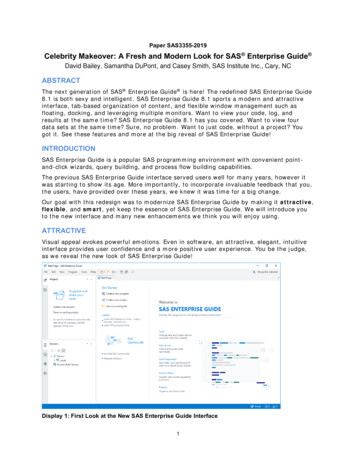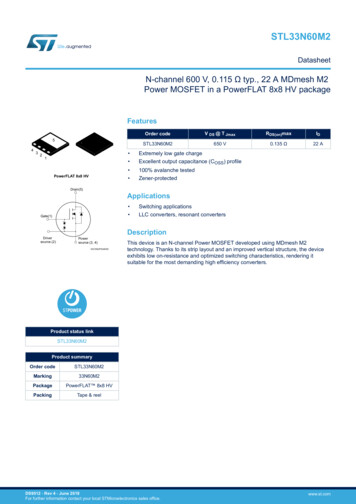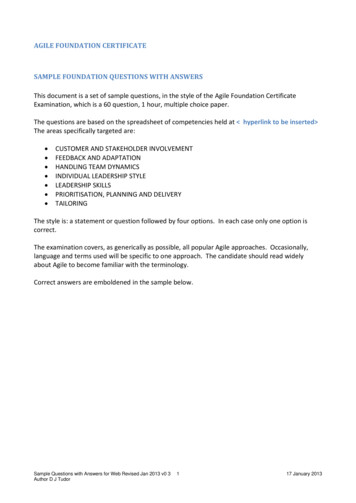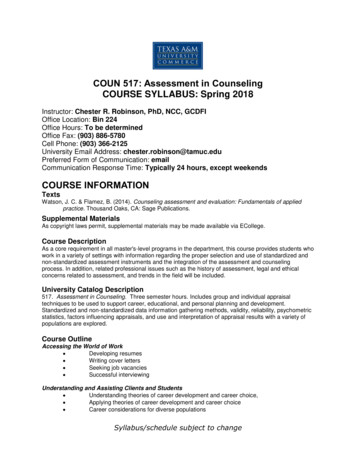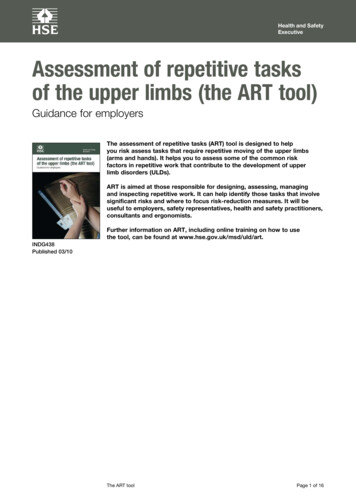
Transcription
Health and SafetyExecutiveAssessment of repetitive tasksof the upper limbs (the ART tool)Guidance for employersThe assessment of repetitive tasks (ART) tool is designed to helpyou risk assess tasks that require repetitive moving of the upper limbs(arms and hands). It helps you to assess some of the common riskfactors in repetitive work that contribute to the development of upperlimb disorders (ULDs).ART is aimed at those responsible for designing, assessing, managingand inspecting repetitive work. It can help identify those tasks that involvesignificant risks and where to focus risk-reduction measures. It will beuseful to employers, safety representatives, health and safety practitioners,consultants and ergonomists.Further information on ART, including online training on how to usethe tool, can be found at www.hse.gov.uk/msd/uld/art.INDG438Published 03/10The ART toolPage 1 of 16
Health and SafetyExecutiveAssessment guideRepetitive tasks are made up of a sequence of upper limb actions, of fairly shortduration, which are repeated over and over again, and are almost always the same(eg stitching a piece of cloth, manufacturing one part, packaging one item). ART is most suited for tasks that: involve actions of the upper limbs; repeat every few minutes, or even more frequently; and occur for at least 1–2 hours per day or shift.The tasks are typically found in assembly, production, processing, packaging,packing and sorting work, as well as work involving the regular use of handtools.ART is not intended for display screen equipment (DSE) assessments.ART is made up of three sections: The assessment guide – this provides detailed information about how to usethe tool, the risk factors and the assessment criteria. Read it carefully beforeusing the tool. The flow chart – this provides an overview of the assessment process. It alsoguides experienced users through the tool fairly quickly. The task description form and score sheet – this provides a place torecord information about the task as well as the findings of the assessment.Before completing ART Spend some time observing the task to ensure that what you are seeing isrepresentative of normal practices.It is important to consult workers and safety representatives during theassessment process.Where several people do the same task, make sure you consult more than oneworker about the demands of the task.It may help to video record the task so you can view it again, away from thework area.Completing the task description form Describe the repetitive task to be assessed.You may find the timeline helpful to mark the times when the repetitive task isperformed and when any breaks or pauses occur. Consider the timing of: meal breaks; other official breaks; other pauses (eg during pauses in production); and any non-repetitive tasks (eg visual inspection task).Making the assessment Decide whether to make an assessment of the left arm and the right arm, orjust the arm that is predominantly involved in the task. If there is any doubt,consider both the left and the right arm.The ART toolPage 2 of 16
Health and SafetyExecutive Ensure you read the assessment guide before you begin your assessment. Youmay be familiar with the manual handling assessment charts (MAC) tool.Although the format of ART looks similar, there are some subtle differences inthe way the tool is used. The assessment is split into four stages: Stage A: Frequency and repetition of movements; Stage B: Force; Stage C: Awkward postures; Stage D: Additional factors. For each stage, follow the flow chart and/or assessment guide to determine thelevel of risk for each risk factor. The levels of risk are classified in the table below.G GREEN Low level of riskA AMBER Medium level of risk – Examine task closelyR RED High level of risk – Prompt action needed Circle the colour band and the corresponding numerical score on the flow chartor assessment guide. It is possible to use intermediate scores if the factor youare assessing falls between two categories. Complete the score sheet, following the instructions on page 10. This willdetermine the task score and exposure score.Taking actionThe purpose of using ART is to identify significant risks and then reducethe level of risk in the task. The task scores and exposure scores help prioritise those tasks that need mosturgent attention and help check the effectiveness of any improvements. The coloursassigned to the risk factors will help identify where to focus risk-reduction measures. Where tasks require attention, first look for ‘higher order’ solutions where it isreasonably practicable to eliminate the hazard, for example, through redesign ofthe work, substitution or replacement of tools or components, or automation ofthe task. Where these measures are not practicable, identify how tasks mightbe improved to avoid or reduce those factors that score red. Then considerhow to reduce the amber scores. If scores for individual risk factors cannot beimproved, then the lowest order in the hierarchy of controls is to minimise therisk by designing suitable systems of work (eg task rotation schedules), usingPPE, if appropriate, and providing training. Preventative measures can be simple and cost-effective (eg making changes tothe working height or placement of work items can allow better arm postures). Consult the people who are doing the repetitive work when exploring andintroducing risk-reduction measures. Employees can be especially good atdevising effective and practical improvement measures. You cannot prevent all ULDs. Suitable systems for early reporting of symptoms,proper treatment, rehabilitation and return to work are essential components formanaging risks and any episodes of ULDs.The ART toolPage 3 of 16
Health and SafetyExecutiveFrequency and repetitionA1 Arm movementsObserve the movement of the arm and select the category that is most appropriate.It is possible to select intermediate scores. Assess both the left (L) and right (R) arm.ArmmovementsareLRInfrequent (eg some intermittent movement)00Frequent (eg regular movement with some pauses)33Very frequent (eg almost continuous movement)66A2 RepetitionThis refers to movement of the arm and hand, but not the fingers. Observe themovement of the arm and hand and count the number of times the same or asimilar pattern of motion is repeated over a set period of time (eg 1 minute). Assessboth the left (L) and right (R) arm.Similar motionpattern of thearm and hand isrepeatedThe ART toolLR10 times per minute or less0011–20 times per minute33More than 20 times per minute66Page 4 of 16
Health and SafetyExecutiveForceB ForceUse the grid below to determine the level of force exerted with the hand and theamount of time that the force is exerted. It is possible to select intermediate scoreson the grid if appropriate. If more than one type of force is exerted, select thehighest score obtained with the grid.There are two methods to determine the level of hand force: Ask the person doing the work if there are any actions that require muscle effortof the arm, hand or fingers. If such actions are identified, ask the worker todescribe the level of force involved in each action (eg light force, moderateforce, strong force, or very strong force). Otherwise, use the written descriptions below to determine the level of forceexerted with the hand.Light forceThere is no indication of any particular effortModerate forceForce needs to be exerted. For example: Pinching or gripping objects with some effort Moving levers or pushing buttons with some effort Manipulating lids or components with some effort Pushing or forcing items together with some effort Using tools with some effortStrong forceForce is obviously high, strong or heavyVery strong forceForce is near to the maximum level that the worker can applyWorker’s description of the level of force exerted with the handLightModerateStrongVery strongInfrequentG0A1R6Changesrequired*Part of thetime(15–30%)G0A2R9Changesrequired*About half thetime (40–60%)G0A4R12Changesrequired*Almost allthe time(80% or more)G0R8Changesrequired*Changesrequired** Changes to the task are required due to unacceptable levels of force.The ART toolPage 5 of 16
Health and SafetyExecutiveAwkward posturesDetermine the amount of time that the worker spends in the postures describedbelow. This includes the time spent moving to a bent or twisted position repetitivelyand the time spent holding a bent or twisted position.C1 Head/neck postureThe neck is considered to be bent or twisted if an obvious angle between the neckand back can be observed as a result of performing the task.The head or neck is:In an almost neutral posture0Bent or twisted part of thetime (eg 15–30%)1Bent or twisted more than halfof the time (more than 50%)2C2 Back postureThe back posture is considered awkward if more than 20 of twisting or bending isobserved.The back is:In an almost neutral posture0Bent forward, sideways or twistedpart of the time1Bent forward, sideways or twisted formore than half of the time2C3 Arm postureThe arm is considered to adopt an awkward posture if the elbow is raised toaround chest height and the arm is unsupported (eg not resting on a workbench).LRKept close to the body orsupported00Raised away from the bodypart of the time22Raised away from the bodymore than half of the time44The elbow is:The ART toolPage 6 of 16
Health and SafetyExecutiveC4 Wrist postureThe wrist is considered to be bent or deviated if an obvious wrist angle can beobserved.LRAlmost straight/in aneutral position00Bent or deviated partof the time11Bent or deviated morethan half of the time22LRPower grip or do notgrip awkwardly00Pinch or wide fingergrip for part of the time11Pinch or wide fingergrip for more than halfof the time22The wrist is:Deviated wristBent wristC5 Hand/finger gripThe hands or fingers hold objects in a:Wide fingerPinchPowerPinchThe ART toolPage 7 of 16
Health and SafetyExecutiveAdditional factorsD1 BreaksDetermine the maximum amount of time that individuals perform the repetitive taskwithout a break. Breaks are significant changes or pauses (eg of at least 5–10minutes) in arm or hand activity. They include structured breaks such as mealbreaks. They also include time spent performing other tasks that do not involvesimilar repetitive arm movements (eg a visual inspection task).The worker performs the task continuously, without a break, for:Less than one hour, or there are frequent short breaks (eg of at least10 seconds) every few minutes over the whole work period01 hour to less than 2 hours22 hours to less than 3 hours43 hours to less than 4 hours64 hours or more8D2 Work paceSpeak to the workers about any difficulties they might have keeping up with thework. Select the most appropriate category. If the score is amber or red, ask formore information about this aspect of the work.Not difficult to keep up with the work0Sometimes difficult to keep up with the work1Often difficult to keep up with the work2D3 Other factorsIdentify any other factors that are present in the task. For example: gloves affect gripping and make the handling task more difficult;a tool (eg hammer, pick) is used to strike two or more times a minute;the hand is used as a tool (eg hammer) and struck ten or more times per hour;the tools, workpiece or workstation cause compression of the skin;the tools or workpiece cause discomfort or cramping of the hand or fingers;the hand/arm is exposed to vibration;the task requires fine precise movements of the hand or fingers;operators are exposed to cold or draughts or grip cold tools; andlighting levels are inadequate.The ART toolPage 8 of 16
Health and SafetyExecutiveSelect the most appropriate category. Assess both the left (L) and right (R) arm.LRNo factors present00One factor is present11Two or more factors are present22D4 DurationDetermine the amount of time that a worker performs the repetitive task in a typicalday or shift (excluding breaks). Select the most appropriate category.Duration of task by a workerDuration multiplierLess than 2 hoursX 0.52 hours to less than 4 hoursX 0.754 hours to 8 hoursX1More than 8 hoursX 1.5D5 Psychosocial factorsPsychosocial factors are not given a score. However, they should be considered,through discussion with workers, and, if present in the workplace, recorded on thescore sheet. They include things such as: little control over how the work is done;incentives to skip breaks or finish early;monotonous work;high levels of attention and concentration;frequent tight deadlines;lack of support from supervisors or co-workers;excessive work demands; andinsufficient training to do the job successfully.The ART toolPage 9 of 16
Health and SafetyExecutiveCompleting the score sheetEnter the colour band and numerical score for each risk factor on the score sheet.There is also a place on the score sheet to record other important findings of theassessment.If you assess both arms, several factors only need to be assessed once. These arehead/neck posture, back posture, breaks, and work pace. However, these scoresshould be entered into the columns for both the left arm and right arm.Follow the instructions below to calculate the task score and exposure score.Calculating the task scoreTo calculate the task score, add together the scores on the score sheet.Task score A1 A2 B C1 C2 C3 C4 C5 D1 D2 D3If you assess both arms, the scores for the left arm and right arm should be keptseparate and not combined.Calculating the exposure scoreIt is possible to adjust the task score to reflect the total duration that the task isperformed by a worker. Multiply the task score by the appropriate durationmultiplier (D4) to calculate the exposure score.X DurationmultiplierTask score ExposurescoreThe task scores and exposure scores help prioritise those tasks that need mosturgent attention and help check the effectiveness of any improvements.The colours assigned to the risk factors will help identify where to focusrisk-reduction measures.A system for interpreting the exposure score is proposed in the table below.Exposure scoreProposed exposure level0–11LowConsider individual circumstances12–21MediumFurther investigation required22 or moreHighFurther investigation required urgentlyEven if the exposure score is low, take into account the requirements of certainindividuals and groups where appropriate (eg new and expectant mothers, workersthat are new, returning to work, or having difficulties with repetitive work). Individualadjustments to the work may still be needed to help accommodate these people.The ART toolPage 10 of 16
Health and SafetyExecutiveDealing with task rotationThe method described on page 10 to calculate the exposure score applies where aworker performs the same repetitive task throughout the day or shift. However, it isrecognised that workers may actually carry out several different repetitive tasks aspart of their job.If workers rotate to other repetitive tasks in their job, you should assess all theirtasks involving repetitive movements of the upper limbs and consider their overallexposure.One method is to use ART to make an assessment of each repetitive task in therotation. Then compare the risk factor colours and scores across the differenttasks. If you find that workers rotate to tasks with similar red scores or high taskscores, the task rotation may not provide enough variation or recovery in the work.In this case, examine the task rotation system further. It is important to speak toworkers about whether the rotation provides sufficient recovery or improves theirwork in other ways.An electronic workbook is also available to calculate the overall score of a jobinvolving several repetitive tasks. This job exposure score helps prioritise jobsinvolving more than one repetitive task. The workbook, along with further informationon how to complete the score sheet, can be found at www.hse.gov.uk/msd/uld/art.The ART toolPage 11 of 16
Health and SafetyExecutiveFurther informationFurther information on ART, including online training on how to use thetool, additional score sheets and task description forms can be found atwww.hse.gov.uk/msd/uld/art.HSE publicationsUpper limb disorders in the workplace HSG60 (Second edition) HSE Books 2002ISBN 978 0 7176 1978 8 www.hse.gov.uk/pubns/books/hsg60.htmSeating at work HSG57 (Third edition) HSE Books 1998ISBN 978 0 7176 1231 4 www.hse.gov.uk/pubns/books/hsg57.htmManual handling assessment charts (the MAC tool) Leaflet INDG383(rev2)HSE Books 2014 www.hse.gov.uk/pubns/indg383.htmHand-arm vibration. The Control of Vibration at Work Regulations 2005.Guidance on Regulations L140 HSE Books 2005ISBN 978 0 7176 6125 1 www.hse.gov.uk/pubns/books/l140.htmManual handling at work: A brief guide Leaflet INDG143(rev3) HSE Books 2012www.hse.gov.uk/pubns/indg143.htmManaging upper limb disorders in the workplace: A brief guide Leaflet INDG171(rev2)HSE Books 2013 www.hse.gov.uk/pubns/indg171.htmThe ART toolPage 12 of 16
Health and SafetyExecutiveFlow chartSimilar motion patternsrepeated 11 to 20 timesper minuteSimilar motion patternsrepeated 10 times perminute or lessVery frequent (eg almostcontinuous movement)Frequent (eg regularmovement with somepauses)Infrequent (eg someintermittent movement)Stage A nSimilar motion patternsrepeated more than 20times per minuteSee grid on page 5 ofthe assessment guideSee grid on page 5 ofthe assessment guideStage B ForceBForce30630GARGAR630630Left RightGARGAR60R01-4ALeft RightGGA1-4R6-12 6-12Bent forward, sideways ortwisted part of the timeAlmost neutralBent or twisted more thanhalf of the timeBent or twisted part ofthe timeAlmost neutralAGRAGARGARGAR01201224012012Never difficult to keep upwith the work4 or more hours ofcontinuous work3 to less than 4 hours ofcontinuous work2 to less than 3 hours ofcontinuous work1 to less than 2 hours ofcontinuous workLess than 1 hour ofcontinuous workAGRRAAG0246801Left RightGG00Sometimes difficult tokeep up with the workNo factors presentA21 factor presentRR2 or more factors presentx 0.52R21Less than 2 hoursx 0.75x 1.5A2 to less than 4 hoursx114 to 8 hoursOften difficult to keep upwith the workStage D Additional ore than 8 hoursStage D Additional factorsTask scoreDurationExposure scoreD1 D2 D3D4 X 21021042Left RightGG00GAAlmost neutral/straightAElbow raised away fromthe body part of the timeBent or deviated part ofthe timeRRBent or deviated morethan half of the timeRAGPinch or wide finger gripfor part of the timePower grip or no awkwardgripElbow raised away fromthe body more than halfof the timeElbow close to the bodyor the arm is supportedR Bent forward, sidewaysor twisted more thanhalf the timeStage C Awkward eC4WristpostureC5Hand/fingergripPinch or wide finger gripfor more than half of thetimeStage B Force scoreStage C Posture scoreStage A Frequency scoreA1 A2B C1 C2 C3 C4 C5See grid on page 5 ofthe assessment guideLeft handRight handPage 13 of 16The ART tool
Health and SafetyExecutiveTask description formAssessor name:Date:Company name:Location:Name of task:Task description:What is the weight of any items handled?If items weigh more than 8 kg and the task involves manual handling consider using the MACWhich side of the body is primarily involved?LeftrightbothWhat hand tools are used?units per shift, hour or minute (circle as appropriate)Production rate (if available)How often is the task repeated?everysecondsDraw the breaks in the shiftFirst hourHow long does aworker perform thetask? without a breakhours in a typical day or shift (excluding breaks)hoursHow often does an individual perform the task? (eg daily, weekly, etc)How often is the task carried out within the organisation? (eg daily, etc)Do workers rotate to other tasks?If so, what tasks?You can download further copies of these forms at www.hse.gov.uk/msd/uld/artThe ART toolPage 14 of 16
Health and SafetyExecutiveScore sheetEnter the colour band and numerical score for each risk factor in the table below.Follow the instructions on page 10 to determine the task score and exposure score.Left armRisk factorsColourRight armScoreColourScoreA1 Arm movementsA2 RepetitionBForceC1 Head/neck postureC2 Back postureC3 Arm postureC4 Wrist postureC5 Hand/finger gripD1 BreaksD2 Work paceD3 Other factorsTask scoreXD4 Duration multiplierXExposure scoreD5 Psychosocial factorsAre there other indications that the task is high risk?The task or similar tasks have a history of ULDs (eg company accidentbook, RIDDOR reports, medically diagnosed cases of upper limb disorders).There are signs workers find the task difficult (eg wearing arm supports orbandages, reporting discomfort, aches or pains). Ask the workers if theyhave any of these symptoms.Other indications? If so, describe:The ART toolPage 15 of 16
Health and SafetyExecutiveFurther informationFor information about health and safety, or to report inconsistencies or inaccuraciesin this guidance, visit www.hse.gov.uk. You can view HSE guidance online andorder priced publications from the website. HSE priced publications are alsoavailable from bookshops.This guidance is issued by the Health and Safety Executive. Following the guidanceis not compulsory, unless specifically stated, and you are free to take other action.But if you do follow the guidance you will normally be doing enough to comply withthe law. Health and safety inspectors seek to secure compliance with the law andmay refer to this guidance.This document is available at www.hse.gov.uk/pubns/indg438.htm. Crown copyright If you wish to reuse this information visit www.hse.gov.uk/copyright.htm for details. First published 03/10.Published by the Health and Safety Executive10/15INDG438Page 16 of 16
The ART tool Page 3 of 16 Health and Safety Executive Ensure you read the assessment guide before you begin your assessment. You may be familiar with the manual handling assessment charts (MAC) tool. Although the format of ART looks similar, there are some subtle differences in the way the tool is used. The assessment is split into four stages:

